
If you will be backpacking for a long distance, keeping the weight of your backpack down is essential. You might think that a few additional ounces do not make a difference, but these ounces add up after a few days of walking, making your backpack so heavy. The tent might be the heaviest item in your backpack, followed by your backpack and the sleeping bag. If you can shed a few pounds from your package, you will find it easier to walk long distances and enjoy your backpacking more.
Although you need a light package, you shouldn’t cut corners when it comes to tent quality. You still need to pick a high quality tent that not only protects you from elements but also lasts for many camping seasons. The best lightweight tents under 100 dollars should match your needs succinctly. Pick one big enough to accommodate the number of sleepers and protective enough to keep off elements in the camping grounds – I will explain that below.
For this guide, I considered the following factors to give you the recommendations:
Coleman Sundome Tent
Alps Mountaineering Lynx 1-Person Tent
Coleman Hooligan Backpacking Tent
Wenzel Alpine 3-Person Tent
Weanas Professional Backpacking
Moon Lence 2-Person Camping Tent
BISINNA 2-Person Camping Tent
HILLMAN 3-4 Season 2-3-Person Backpacking Tent
BFULL Pop-Up Camping Tent
Bessport 2-Person Camping Tent
What should you consider when shopping for the best backpacking tent under 100 dollars?
A good tent should offer a great balance between quality, lightweight, weatherproofing, and functionality. Granted, you need to ensure the material is strong enough to last long, waterproofed to protect you from light showers of rain, and breathable to keep out condensation and heat.
Below is a breakdown of the factors you should consider:
Backpacking tents accommodate between one and four persons. Most brands and models include the capacity in the title of the tent. There are no industry standards on the size of a two-person or bigger tent, so, there are size variations from brand to brand.
If you have a plus-size body, you need a larger tent, so you can go for one that has a few extra inches to accommodate your figure. You can also go for a two-person tent to accommodate you and your gear comfortably. If having more space on the floor is essential, compare different brands to pick the tent that meets your needs.
Tents sport either a three- or four-season construction. The majority of tents on the market are three-season tents as they are the most versatile. If you are not camping in winter, a 4-season tent will only be an extra cost for you.
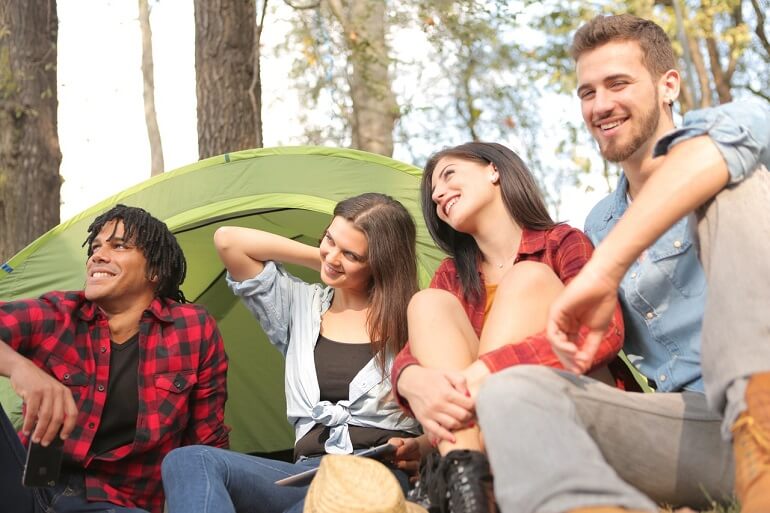
Three-season tents are ideal when you need to camp from spring through fall. They are lighter than 4-season tents and cheaper than them too. When sturdily set, the tents can withstand downpours and sometimes light snow. However, they will break under storms, strong winds, and heavy snow.
A 3-season tent comes with ample mesh panel, windows, and doors, to facilitate airflow in and out of the tent. They have fewer poles, and the fabrics are light to reduce the weight. The walls are upright to create more headroom.
If you backpack in early spring or late fall, you might encounter snow. Although the snow may only be light, most 3-season backpacking tents may not withstand it. These are also ideal when you camp in high elevation areas where the winds are strong, and you might experience snow. They have all the features of a three-season tent on top of which they have:
4-season tents are all-season tents. Their design allows them to withstand the harsh winter weather, including fierce winds, snow, and storms. Some of these tents have less ventilation and might feel stuffy during hot weather. They are also heavier than other tents. Some of their features include:
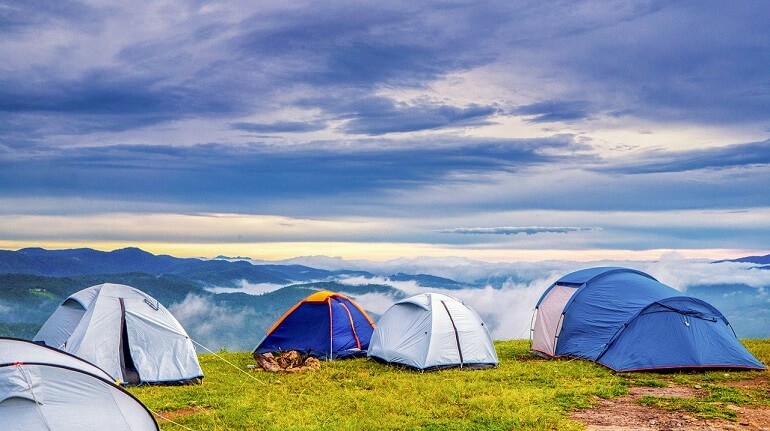
The weight of your backpacking tent is important, whether you are backpacking for a few days or a few weeks. Most manufacturers work to shed as much weight as possible. However, as the tent gets lighter, you miss out on additional features such as pockets, you get less space, and the tent material may not be durable. Granted, you need to shop carefully to pick a tent that balances weight, quality, and functionality.
The weight of the tent depends on its seasonality and capacity. Even as you go for a lightweight tent, do not compromise on quality and functionality. On tent weight, consider the following:
Trail weight – This is the weight of the bare essentials of the tent, including tent body, the fly, and frames. You might need more gear, such as stakes and footprint. Depending on where you will camp, you can shop for a tent that doesn’t have a rainfly but instead has waterproof construction. If you will be camping in a less windy area, a tent with fewer poles and fewer stakes will come in handy.
Packed size – The packed size refers to the amount of space that a tent occupies when you pack it down. Most tents come with a carry bag that compresses the tent to make it easier to carry. You can reduce the packed size by splitting the contents of the tent amongst the campers. For a two-person tent, one person can carry the poles and the stakes and the other to carry the tent fabric and rainfly.
While the last four tents in the list above are lightweight for your backpacking trip, they are less protective against elements, and you can only use them for summer camping in an area where the winds do not blow furiously.
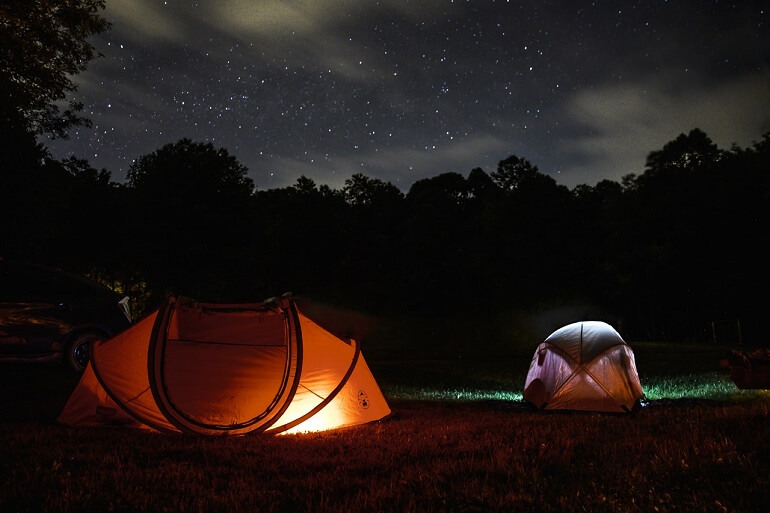
Livability refers to the list of features that make the tent habitable in different weather conditions. For starters, you need a tent that offers you enough room to sleep and to hold your backpacking gear. A while ago, backpacking tents sported sloping walls with minimal head and floor space. While the tents were light, they were less comfortable. Today, the interior spaces of tents look and feel more inviting. When shopping for a tent, consider the following features for enhanced livability:
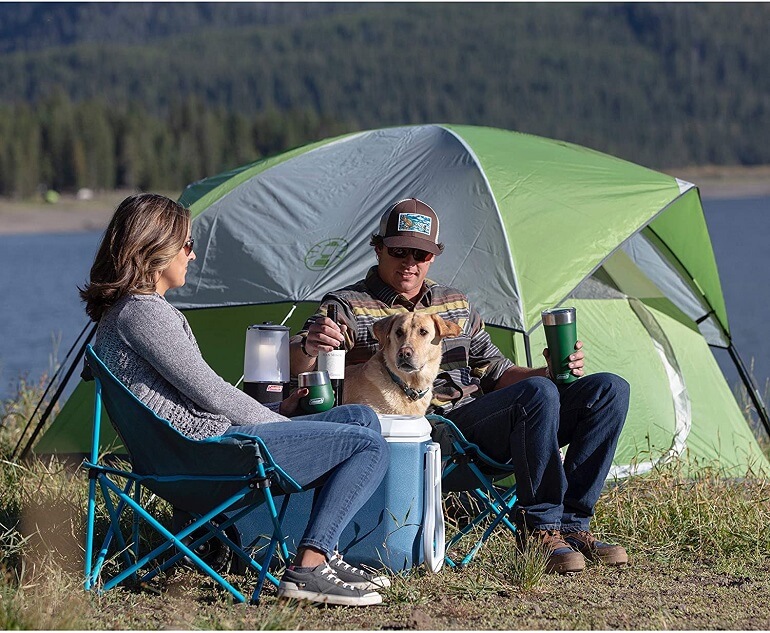
How easy is it to set up a tent? Most tents come with easy to set up designs that you can set up in less than 10 minutes. Pop-up tents are the easiest to set up and only take a few minutes. Consider the following features to choose an easy-to-setup tent design:
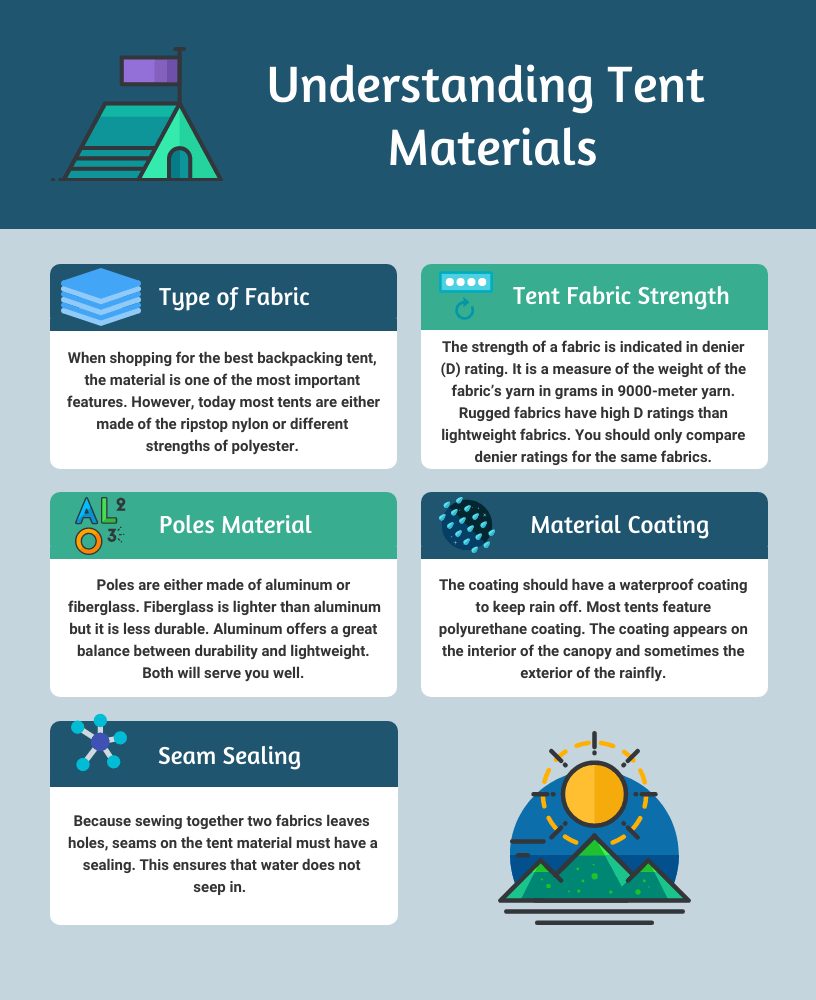
Material: Polyester
Capacity: 4
Weight: 9 pounds
Size: 9 feet by 7 feet
The Coleman Sundome is a large 4-person tent. It sports a weatherproof construction with welded corners and inverted seams to ensure that water doesn’t get in. Further, Coleman provides a rainfly that protects you from the weather.
According to Coleman the tent can withstand winds as strong as 35 miles per hour and string rain. It keeps elements out to keep you warm, but it also keeps you cool during warm weather through its large windows and its ground vent. With enhanced airflow, the tent will never get humid or excessively hot. It has an E-port that makes it easier for you to bring electrical power in the tent. Inside, you can fit a queen-size air bed.
The polyester material coupled with strong frames makes this tent a great unit for rugged use. You can set it up in 10 minutes.
Pros
Cons
Material: Polyester
Capacity: 1
Weight: 4 pounds 1 ounce
Size: 2 feet 8 x 7 feet 6
The Lynx Tent is an easy to set up 1-person tent. It’s a freestanding tent with two poles that you can set up in less than 10 minutes. It comes with a polyester tent fly that keeps off the water and resists UV damage. Better yet, it has a vestibule that gives you extra storage. Although it is a small tent, it still comes with storage pockets, guy ropes, and a gear loft. It has eight zippers each designed not to let in water and one doorway that ventilates the room.
With its weatherproof fly buckles, the tent offers much adjustability and protection from elements. It is easy to wash and dries within a few hours.
Pros
Cons
Material: Polyester
Capacity: 3
Weight: 7.8 pounds
Size: 8- by 7-foot
The Coleman Hooligan is a 3-4 person tent – 4 small-bodied adults and three large-bodied adults. It sports a high quality polyester construction to last many camping seasons. The polyester material is easy to clean with or without a washing machine. It dries fast after washing and after rain. After the camp, the bag folds into a small package that fits in your backpack.
At 8- by 7-foot, the tent accommodates up to three camp pads allowing every camper to sleep freely. It has a vestibule that offers more space in the tent. Each tent comes with snag-free continuous pole sleeves for easy setup – you can set up the tent in ten minutes. Coleman uses WatherTec system to keep the tent weatherproof. It also has a full rainfly that protects you from elements.
Pros
Cons
Material: Polyester
Capacity: 3
Weight: 8 pounds
Size: 8.5 by 8 feet
If you need a weatherproof 3-person backpacking tent, this might be a good choice for you. It sports three poles, which make it easy to set up and disassemble. The fiberglass frames feature shock-cording that further facilitates set up. The polyester material used to make the tent is not only durable, but also weatherproofed to protect you. This material withstands the strong wind that you might experience in the wilderness. Better yet, Wenzel waterproofed the seams and the zips to keep everything in the tent dry.
Inside the tent is an integrated mud mat with a drainage strip allowing you to keep the tent clean. Its two mesh windows and D-style front door ventilate the room during hot days. There is also a gear loft and hanging pockets further giving you more storage space.
Pros
Cons
Material: Polyester
Capacity: 4
Weight: 6.2 pounds
Size: 6.9 by 6.9 feet
This is a 3-4 person tent designed to last long. If you need a one- or two-person tent, Weanas offers those two with the same features as this one. It is a three-weather tent that you can use season-in, season out. When shopping, pick from a choice of four colors to match your taste. As a large tent design, it comes with two doors for enough ventilation during hot summer days. It also has two ventilation skylights which further make the room cool. These skylights are closeable to keep out elements.
Weanas uses a waterproofed polyester fabric that makes the tent withstand up to 4000mm of rain. The material is also resistant to UV rays from the sun and keeps out wind that you may experience in the wilderness. The aluminum poles are lightweight and make it easy to set up the tent.
Pros
Cons
Material: Polyester
Capacity: 2
Weight: 5.6 pounds
Size: 7 by 5 feet
Although the Moon Lence tent only accommodates two people, it is spacious enough to take a third. With its roomy construction, two campers will sleep comfortably. It is a lightweight tent for two people and comes with a small carry bag. It offers all-round protection, thanks to its high-quality polyester material. It can withstand 1000mm rain and also blocks harmful ultra-violet rays from the sun. For the rain, the tent comes with a separate rainfly. Its double-layer construction makes it resistant against harsh weather in the wilderness.
You are offered two shock cords connecting poles and clips on the tent to make it easy to set up. It takes up to 15 minutes. To set up, you have nine lightweight pegs and four guy ropes for a sturdy setup.
Pros
Cons
Material: Polyester Taffeta
Capacity: 2
Weight: 4.72 pounds
Size: 6.9 by 4.6 feet
BISINNA uses high quality polyester taffeta on their 2-person tent to enhance its durability and its functionality. The rainfly also comes with the same high-quality material to keep off the rain. Further, the company uses high quality aluminum to withstand heavy rain. Better still, it is a double-layered tent which makes it stronger to withstand wind and other elements, making it a 3-season tent.
On warm days, the tent keeps you cool, thanks to its mesh ventilation and its two doors. It comes with eight alloy pegs and two wind ropes that keep it sturdy during strong winds. The freestanding tent only requires 10 minutes to set up with its double flysheets.
Pros
Cons
Material: Polyester
Capacity: 2-3
Weight: 5.7 pounds
Size: 6.9 by 4.6 feet
The Hillman Backpacking tent comes in a choice of seven colors so you can choose what meets your camping/backpacking theme. It might easily pass as the best backpacking tent under 100 dollars for anyone looking for a spacious 2-person tent – but it is still large enough to accommodate three campers.
The tent has a mesh section that keeps the tent ventilated during warm summer days. It sports a waterproofed material to withstand light showers of rain. This material is strong to last for many camping seasons. Hillman includes inverted seams and concealed zippers to ensure no section lets in rainwater. For a tent that accommodates up to three campers, it is pretty lightweight at 5.7 pounds.
You can use this tent for summer and spring backpacking, but it is not so ideal for winter.
Pros
Cons
Material: Polyester
Capacity: 2-3
Weight: 7.4 pounds
Size: 6.9 by 5.9 feet
This might be the best 2 person backpacking tent under 100 dollars if you are looking for space and ease of set up. As a pop-up tent, you can set up this tent in a minute or less. Its sturdy poles come connected to the fabric and uses an automatic hydraulic system to set up fast. These fiberglass poles are highly durable and strong under strong wind.
The BFULL Pop-Up tent features a fire retardant polyester flysheet that can withstand up to 5000mm of rain. It is a double-layered tent with all the seams taped to ensure that no drop seeps into the tent. Being rainproof, waterproof, and sunproof, you can use the tent in different seasons. Unlike other tents, you will not feel any chemical smell emanating from the tent even when it is new. Granted, you can start using it out of the box. It packs into a small package into the carry bag provided.
Pros
Cons
Material: Polyester
Capacity: 2
Weight: 5.2 pounds
Size: 7.2 by 4 feet
If you are looking for a light backpacking tent, the Bessport tent might be the best tent under 100 dollars for you. The company toned the tent down to make it more functional while eliminating too much weight. You can use it in different seasons, thanks to the versatile construction. During hot days, the micro-mesh fabric and the zippers keep it ventilated for comfort. During windy and cold and rainy weather, its double-layer fabric, taped seam, and full coverage rainfly, keep the tent weatherproof.
It is easy to set up and take down the tent, thanks to its pre-attached poles. The freestanding tent is not only light, but also packs down into a compact package in its carry bag.
The tent has two D-shaped doors for added ventilation and two vestibules, offering you more space to hold your shoes and other items. Its welded floor design keeps you protected from wet grounds and critters that may want to get into the tent.
Pros
Cons
A three-season tent keeps you comfortable spring through fall. Tents rated as three-season sport a design that makes them resist strong winds and block harmful ultraviolet rays. For use during summer, the tents feature mesh sections and ventilation to protect you from the sun while still maintaining high breathability.
Tarp tents are great when you need an ultra-light tent that costs you less than half the money. It comes as a solid sheet that you can tie to trees. The problem comes when you camp in an area where there are no trees and you are forced to use it as a blanket. You need good knotting skills to set up the tent right and get protection from the rain and wind. Another disadvantage is that the tent has no walls or floor which exposes you to bugs, critters and wet grounds.
If you will be camping in summer in an area where there are trees and fewer bugs, a tarp will save you the heavy load of frames and the extra cost.
A-frame tent designs have sloping walls almost in the shape of letter A. These designs have limited head and elbow space. They also have broad walls that may be battered in the event of strong winds which make them ideal only for short-term use. Modified A-frames, on the other hand, have a center hoop pole, curved walls, and a ridgeline pole to create more space inside.
Two doors are advantageous on the best 4 person tent under 100 dollars. In a tent that accommodates more than one person, two doors offer enough ventilation to keep the indoors cool. On a 1-person tent, a single door is enough to facilitate the circulation of air. Ensure that the zips or Velcro on the door are waterproofed.
Double-wall tents come with an inner canopy (where you sleep) and a separate rainfly that keeps water out. They are less expensive, they keep your tent dry when it rains, and they allow more circulation of air. However, they are heavier than single-wall tents and the circulation reduces after you close the rainfly. On the other hand, single-wall tents have one layer made of waterproof and breathable fabric. This makes them lighter and allows you to set them fast. However, condensation might be a challenge with these tents. You can shop for designs with a partial rainfly that keeps off condensation.
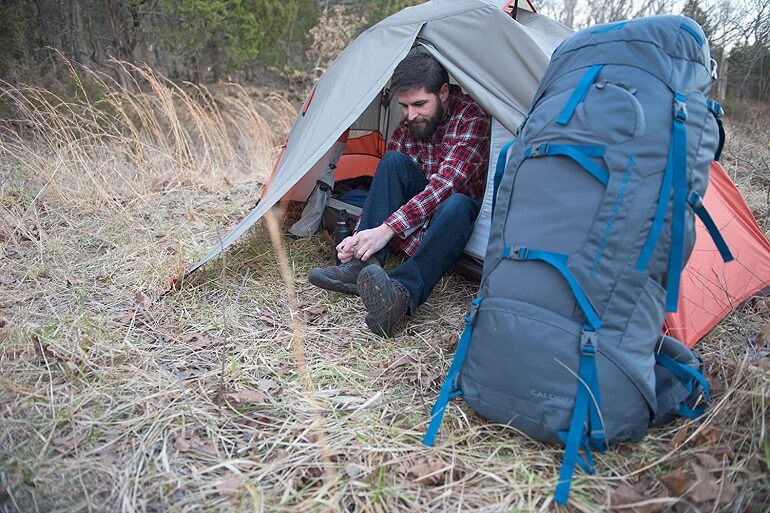
Although you must pick a tent that meets your backpacking and camping needs, a versatile tent is better. Such a tent will still protect you when the season and the camping grounds change. The Coleman Sundome Tent is my recommendation for backpackers looking for a versatile tent. It is a 4-person tent made of high-quality materials to last long and is easy to set up. It is a freestanding tent that offers excellent value and versatility.
If you’d rather buy a one-person tent, the Alps Mountaineering Lynx 1-Person Tent is my recommendation. Although it is not as versatile as the first tent, it sports high-quality construction to protect you from elements and last for many camping seasons. It is also the lightest tent on this list and comes with additional features, including pockets, vestibule, and a gear loft.
Want to read more camping reviews, you can click below:
10 Best Wood Burning Backpacking Stoves For Hikers
10 Best Camping Plates And Bowls
10 Best Hiking Boots Under $100
10 Best Outdoor Watches Under $100
10 Best Heavy Duty Camping Chairs
© 2021 by OutdoorStuffGudies.com
OutdoorStuffGudies.com is a participant in the Amazon Services LLC Associates Program, an affiliate advertising program designed to provide a means for sites to earn advertising fees by advertising and linking to Amazon.com.